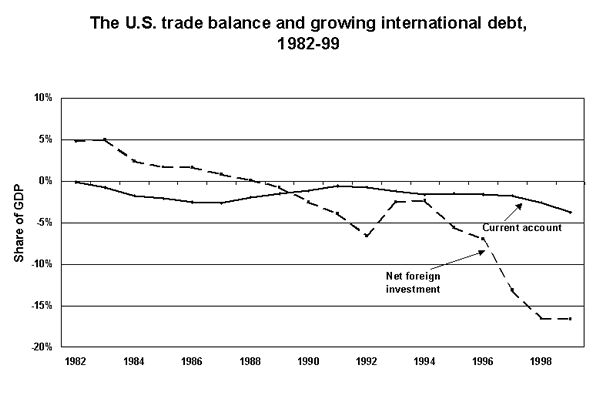A weekly presentation of downloadable charts and short analyses designed to graphically illustrate important economic issues. Updated every Wednesday.
Snapshot for March 7, 2001.
Growing trade deficits threaten U.S. economy
The current account is the broadest measure of a country’s overall trade balance and includes trade in goods, services (including interest and profit), and government payments abroad. The borrowing required to cover chronic current account deficits since the 1980s has turned the United States from the world’s largest creditor nation to the world’s largest debtor (with negative net assets). America’s trade deficits must be financed either by borrowing from foreigners or by selling U.S. assets abroad — in either case, increasing our net international indebtedness. The figure below shows the US net international investment position from 1982 to 1999, as a share of GDP. The United States was a net creditor nation as recently as 1988 but has since seen its accumulated net international debt soar to 16% of GDP, or about $1.5 trillion in 1999, making the U.S. the world’s largest debtor nation.1

Source: U.S. Department of Commerce, International Transactions Tables: http://www.bea.doc.gov/
The financial disasters of the 1980s and 1990s in both developing and industrialized countries have clearly shown that too much external borrowing and accumulated international debt can precipitate financial crises and economic collapses. Whenever a country’s current account deficit becomes large and unsustainable, policy makers must ask whether a financial or economic crisis is inevitable, or if more gradual and less harmful outcomes are possible. A sudden drop in the value of the currency or a sharp rise in interest rates can throw a country into financial crisis, followed by a potentially severe economic downturn.
Mexico, Russia, Korea, and many other countries in Asia and Latin America were hard hit by financial crises associated with large current account deficits between 1997 and 1999. Sweden and Denmark in the 1980s, and the United Kingdom in the early 1990s all experienced such crises. In each case, current account deficits equal to 3.6-5.0% of GDP triggered falling exchange rates and a sharp rise in interest rates.
1. This measure of net U.S. debt includes foreign direct investment valued at current market prices.
This week’s Snapshot by EPI economist Robert E. Scott.
Check out the archive for past Economic Snapshots.
